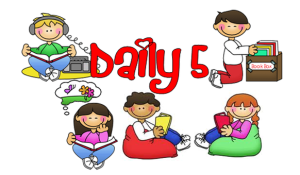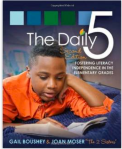
Retrieved from: http://mrsshannonsclass.weebly.com/daily-5.html
Recently, a co-worker of mine started using The Daily 5 (Boushey & Moser, 2014) with their students. Before knowing exactly what the program consisted of, I knew that literacy was a key component. This summer I decided to buy the book to find out more about this interesting approach to literacy and how it can be used to improve student literacy skills.
What is the Daily 5 (les 5 au quotidien)?
The Daily 5, is a round of literacy activities students participate in during their literacy or Language Arts block. At the beginning of each Daily 5, the teacher conducts a Focus lesson and then students can select from one of the daily 5s to work on during each round (Boushey & Moser, 2014). These include:
- Reading to Self (Lecture à soi)
- Work on Writing (Travaux d’écriture)
- Read to Someone (Lecture à un autre)
- Listen to reading (Écouter la lecture)
- Word Work (Étude de mots)
While students are busy working with one of the Daily 5 activities, the teacher has the opportunity to conduct individual conferencing, guided group reading/writing, as well as assessments (Boushey & Moser, p. 19). Length of Daily 5 blocks and the amount of Daily 5 blocks will vary depending on time assigned to literacy, experience of students and time during the school year.
A side note about the French translation:
This program was originally created in English and the French translations for this program vary. I have selected the French translation from Littér@tout.
How does this approach differ from my current teaching?
The Daily 5 is a very similar approach to literacy instruction I use within my classroom. During our literacy block, students conduct silent reading, listen to reading, reading to a friend, guided reading and word work, which are almost all of the elements of the Daily 5. How it differs is that this approach adds writing as an option during the literacy block, whereas my approach focuses on writing during writing instruction. This approach also uses shorter rounds of literacy allowing students to participate in more than one or two literacy activities (based on their own choice), instead of using only one block to conduct reading or one block for writing. These shorter periods helps with sustaining stamina and maintaining interest. I value the fact that students have choice in their learning.
Why I have decided to implement the Daily 5 for literacy?
I believe the Daily 5 is a balanced approach to literacy as writing, word work and reading are grouped together as activities performed by students. These activities are not too lengthy as each round of Daily 5 ranges between 30-40 minutes (Boushey & Mosher, 2014) so students can be more successful at maintaining stamina while exhibiting desirable working behaviours. I appreciate that this approach frees teachers from managing behaviours to working with a few different groups of students or individuals to meet their learning needs. Overall, this is an approach I would like to implement into my classroom this upcoming school year. It will be interesting to see if students are more motivated to read and write through this approach, especially in French.
Daily 5 resources
Student Weekly Check-in
A Daily 5 weekly check-in can be used to help younger students self-monitor what activities they have completed during the week. Here is an example of one I made where students colour the Daily 5 activity once completed and add their own words to the “other” section if they read with me or were completing an audio task.
Daily 5 check-in (Click on the link to get your own copy, you can also add a column on top of the categories and add the picture of each of the Daily 5 activities).
Teacher Check-in Sheet
Some teachers prefer to monitor the student activities themselves or have them check-in prior to starting a round of Daily 5, here is an example of a French check-in sheet I created to record student’s activities. The first sheet has room for 10 students, the second sheet has room for 15 students. For Student and Teacher check-in’s in English, refer to the Online resources section.
Teacher Daily 5 Check-in Sheet (Click on the link to get your own copy)
Online Resources
The Daily 5 and Math Daily 3 Resources from Gail Boushey & Joan Moser: www.thedailycafe.com
MNWElementary – Daily 5 Wiki Site: http://mnwelementary-daily5andcafe.wikispaces.com/Daily+5+Resources
Mrs. Shannon’s Math Class Website: http://mrsshannonsclass.weebly.com/daily-5.html
English Daily 5 posters courtesy of The Teacher Wife: http://www.theteacherwife.com/2012/06/daily-5-chapter-1.html
References:
Boushey, G., & Moser, J. (2014). The daily 5: Second edition. Portland, Maine: Stenhouse Publishers.









